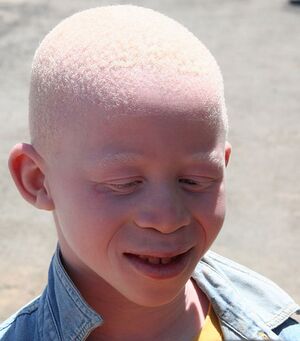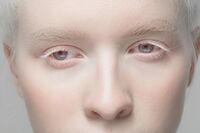Albinism
Introduction[edit | edit source]
Albinism, a latin word albus that means "white" is a genetic condition characterised by a lack of melanin.[1] Melanin is a pigment that gives colour to the hair, skin and eyes. It is inherited when an individual receives two copies of a recessive gene that causes a lack of melanin production. There are different types of albinism.
- Oculocutaneous Albinism (OCA): This affects the person's skin, hair, and eyes. Due to little or no melanin in these areas, the skin and hair color is very light with blue or violet eyes. OCA is further subdivided into (based on mutations involved):
- OCA1
- OCA2
- OCA3
- OCA4
- Ocular Albinism (OA): This primarily affects the eye. These individuals may have little or no pigmentation in the iris and retina that leads to vision problem. In OA the skin and hair colour might appear normal. This is associated with issues such as Nystagmus and strabismus.[2]
Relavent Anatomy[edit | edit source]
Skin[edit | edit source]
The skin has three layers namely, Epidermis - Outermost layer, Dermis - Provides support and nourishment, Hypodermis - Deepest layer. There are various cells that are present in the epidermis and dermis that contribute to the structure and function of skin such as Keratinocytes, Melanocytes, Langerhans cells, Fibroblasts, Adipocytes and Mast cells.
The Melanocytes are the cells that produce a pigment named melanin that gives colour to the skin, hair and eyes.[3]
Genetic Mutation[edit | edit source]
Genes are segments of DNA that determines the way for the synthesis of proteins and other molecules. Mutation in albinism affect specific genes that responsible for various functions. These include:
- TYR (Tyrosinase) Gene: This gene provides instruction for the production of tyrosinase that is crucial for melanin synthesis. Due to mutation in this gene there is insufficient or nonfunctional tyrosinase, thus leading to lack of melanin.
- OCA2 Gene: This gene is associated with the regulation of melanin production and distribution. A mutation in the gene affects the quantity and distribution of melanin in the skin, hair and eyes.
- TYRP1(Tyrosinase- Related Protein 1) Gene: This provides instructions for the production of tryosinase-related protein 1, which involved in melanin synthesis and maturation. A mutation can impair the synthesis and maturation of melanin.
- SLC45A2 Gene: The gene is associated with the transport of melanin precursors within melanocytes. The mutation can disrupt the normal transport of melanin precursors, affecting the production and distribution of melanin.
- GPR143 Gene: This gene is associated with OA and plays a role in the development and function of the eyes. The mutation in this gene can impact the development of the Optic Nerve and other structures in the eyes, leading to visual impairments.[4]
Sub-Types of Albinism[edit | edit source]
| OCA1[5] | OCA2 [2][4] | OCA3 [2][4] | OCA4 [2][4] |
|---|---|---|---|
| Mutations in TYR Gene
Chromosome 11 Tyrosine deficiency |
Mutations in OCA2 Gene
Chromosme 15 Melanosomal membrane protein |
Mutations in TYRP1 Gene
Chromosome 9 Stabilizes Tryosinase |
Mutations in SLC45A2 Gene
Chromosome 5 Membrane Transport protein |
| OCA1a: Complete absence of melanin
OCA1b: Some melanin present |
Brown OCA | Red OCA | Nearly normal melanin |
| Most common globally | Common in people of African | Common in southern Africa | Common in East Asian |
Causes of albinism[edit | edit source]
- Genetic basis: Albinism is primarily a genetic disorder, hence involves mutation of genes
- Melanin production: Due to genetic mutations, there is a disruption in the function of melanocytes/Tyrosinase.
- Melanin Distribution: Melanin has to be effectively transferred from melanocytes to surrounding cells in the hair, skin and eyes. In some cases, there may be defects in the transfer or distribution, hence resulting in the pigmentation of tissues.[3]
Clinical Presentation[edit | edit source]
- Very light skin and hair ranging from white and blond to light brown.
- Eye colour can be blue, violet or light grey.
- Lack of Melanin in the iris can lead to increased sensitivity to light.
- Reduced visual acuity is common.
- Nystagmus that can affect the ability to maintain steady visual focus.
- Strabismus (crossed or misaligned eyes) may be present.
- Optic nerve abnormalities.
- Increased susceptibility to sunburn.[7]
Management/Interventions[edit | edit source]
Although there is currently no treatment for albinism aiming for a complete cure, the management focuses on quality of life of the individual which includes correcting refractive errors[8] or eye muscle surgeries.[9]
Those with albinism who receive optical rehabilitation wear glasses for close-up and distant vision. filters to control light and providing instruments such as loupes. People can assist both indoors and outdoors by using a variety of colored and neutral filters.
telescopes for long range viewing and prismatic glasses, hand-held and stand magnifiers for close-up reading are examples of reading aids.
- Optical rehabilitation for individuals with albinism includes glasses for both near and distant vision.
- Filters to manage light, and tools like loupes.
- A variety of coloured and neutral filters can also be used to help individuals inside the house and outside as well.[7] [10]
- Telescopes for long range viewing and prismatic glasses, hand-held and stand magnifiers for close-up reading are examples of reading aids.
- Conventional glasses with base-in-prism could be used due to less expensive and larger field of vision.
- A study has suggested that 77% individuals diagnosed with OCA have reported a significant improvement in reduction of photophobia, relief in eye-strain, and eye discomfort with the use of filters. [11]
Studies have also suggested that the highest referral for low vision services is from ophthalmologists that helps to understand that an effective referral system between healthcare professionals and vision therapists would be necessary to provide effective services. [12]
Current Literature on Physiotherapy Treatment[edit | edit source]
A case report, published in 2022, documented the case of a 10-year-old male child exhibiting nystagmus associated with albinism. The child presented typical complaints of dizziness, evaluated using a Vanderbilt Pediatric Dizziness Handicap Inventory for Patient Caregivers (DHI-PC). Vestibular rehabilitation for nystagmus aimed at improving gaze stabilization, ocular muscle strength, and maintaining vestibular function. The boy successfully recovered through a planned excercise program that included vestibular rehabilitation program, incorporating gaze stability exercises, Cawthorne-Cooksey exercises, habituation exercises, eyeball resistance exercises, eye-hand coordination exercises, and parent education, along with home exercise programs. [13]
Further read on the case report: Vestibular Rehabilitation Thinking Beyond Benign Paroxysmal Positional Vertigo: Inference in a Rare Case of Oculocutaneous Albinism
Refrences[edit | edit source]
- ↑ Kruijt CC, de Wit GC, Bergen AA, Florijn RJ, Schalij-Delfos NE, van Genderen MM. The phenotypic spectrum of albinism. Ophthalmology. 2018 Dec 1;125(12):1953-60.
- ↑ 2.0 2.1 2.2 2.3 Marçon CR, Maia M. Albinism: epidemiology, genetics, cutaneous characterization, psychosocial factors. Anais brasileiros de dermatologia. 2019 Dec 9;94:503-20.
- ↑ 3.0 3.1 3.2 Thawabteh AM, Jibreen A, Karaman D, Thawabteh A, Karaman R. Skin Pigmentation Types, Causes and Treatment—A Review. Molecules. 2023 Jun 18;28(12):4839.
- ↑ 4.0 4.1 4.2 4.3 Yang Q, Yi S, Li M, Xie B, Luo J, Wang J, Rong X, Zhang Q, Qin Z, Hang L, Feng S. Genetic analyses of oculocutaneous albinism types 1 and 2 with four novel mutations. BMC medical genetics. 2019 Dec;20:1-1.
- ↑ Arveiler B, Michaud V, Lasseaux E. Albinism: an underdiagnosed condition. Journal of Investigative Dermatology. 2020 Jul 1;140(7):1449-51.
- ↑ Li C, Chen Q, Wu J, Ren J, Zhang M, Wang H, Li J, Tang Y. Identification and characterization of two novel noncoding tyrosinase (TYR) gene variants leading to oculocutaneous albinism type 1. Journal of Biological Chemistry. 2022 May 1;298(5).
- ↑ 7.0 7.1 Hansen TB, Torner-Jordana J, Kessel L. Photosensitivity and filter efficacy in albinism✰. Journal of optometry. 2023 Jul 1;16(3):214-20.
- ↑ Jayakrishnan G, Nallamuthu P, Giridhar PS. Effectiveness of refractive error correction for people with oculocutaneous albinism in South Indian population.
- ↑ Liu S, Kuht HJ, Moon EH, Maconachie GD, Thomas MG. Current and emerging treatments for albinism. Survey of Ophthalmology. 2021 Mar 1;66(2):362-77.
- ↑ Lisbjerg K, Jordana JT, Brandt VN, Kjølholm C, Kessel L. Vision-Related Quality of Life in Danish Patients with Albinism and the Impact of an Updated Optical Rehabilitation. Journal of Clinical Medicine. 2023 Aug 22;12(17):5451.
- ↑ Shah M, Khan MT, Saeed N. Visual rehabilitation of people with oculocutaneous albinism in a tertiary clinical setting in Pakistan. Saudi Journal of Ophthalmology. 2020 Apr;34(2):111.
- ↑ Qutishat Y, Shublaq S, Masoud M, Alnuman N. Low vision profile in Jordan: a vision rehabilitation center-based study. InHealthcare 2020 Dec 26 (Vol. 9, No. 1, p. 20). MDPI.
- ↑ Badjate DM, Kovela RK, Harjpal P, Morghade SV, Kovela Sr RK, Morghade Jr SV. Vestibular Rehabilitation Thinking Beyond Benign Paroxysmal Positional Vertigo: Inference in a Rare Case of Oculocutaneous Albinism. Cureus. 2022 Oct 19;14(10).








